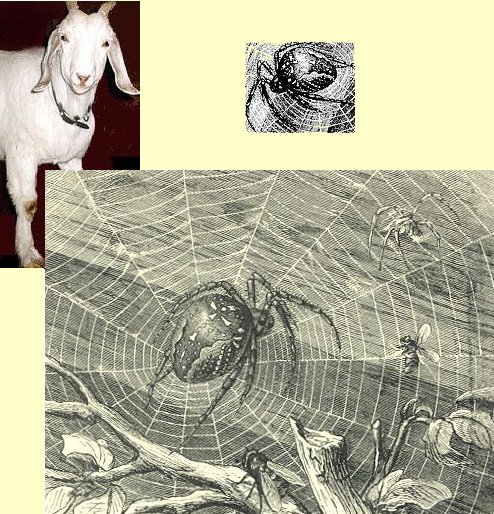Goats & Spider Webs
Today, a progress report. The University of Houston's College of Engineering presents this series about the machines that make our civilization run, and the people whose ingenuity created them.
Years ago I did a program on the wonderful silk that spiders spin to make their webs. Spiders spin far stronger and more adaptable silk than silkworms do. Typically five times stronger than steel, it also has a special capacity for absorbing the energy of an impact. It's ideal for countless applications, but harvesting any amount of it has been impossible. We're lucky to get enough spider silk to make telescope reticules
I concluded that program with a quote from Dryden about the mystery of: ... their own webs from their own entrails spun. Solving that mystery by synthesizing the proteins that make up spider silk was a terrible challenge. And so it remains.
However, science writer Lawrence Osborne now tells of an astonishing cut-the-Gordian-knot solution to the problem. A company called Nexia Biotechnologies has taken over an old maple sugar farm in Quebec. They're raising Nubian goats in that idyllic setting.
The goats are ordinary, playful, friendly animals -- practically pets. However, one spider gene has been stirred into the goat DNA. This gene is programmed to activate only within the female's mammary glands, and only when she's lactating.
Even then, the goats produce seemingly normal, drinkable milk. A fairly simple process produces an astonishing product from the milk. Skim off the fat. Then, when you add salt, a special protein curdles out of the milk. Add water to that protein, and you get essentially the same fluid that's spun by a spider.
Similar gene replacement processes produce many pharmaceuticals. This is fairly routine technology, and it's done without messing up the goats. No Jeff Goldblum turning into a fly here, no Island of Dr. Moreau. These are the same low-technology goats that've provided milk and cheese for millennia. This is not terribly different from processes we use to produce hybrid grain.
Now, as a substantial supply of spider silk becomes available, applications arise. It can be used to make remarkable super-light clothing, biodegradable sutures, body armor, ligament and tendon prostheses -- any number of super-light structural materials. Nexia calls it Bio-steel.
The company is turning a former American Air Force base in northern New York into a much larger goat farm -- one that includes adjacent lab space. Osborne describes how the spider-web-producing goats like to roll down the sloping sides of old grass-grown concrete bunkers for the sheer pleasure of it -- an idyllic spears-into-ploughshares scene. Is it too good to be true?
One naturally holds one's breath when such a radical technology comes along. But here is a potential replacement for so many environmentally unfriendly fibers. Spider webs are pure protein. This is the ultimate biodegradable material. And to receive it from such an amicable creature in comparison with a spider -- well, that's the part that truly seems miraculous.
I'm John Lienhard, at the University of Houston, where we're interested in the way inventive minds work.
(Theme music)
Osborne, L., Got Silk. New York Times Magazine, June 16, 2002, pp. 48-51.
For more on spider silk, see Episode 1069.
For more on the Nexia technology, see: http://www.spacedaily.com/news/materials-02a.html
